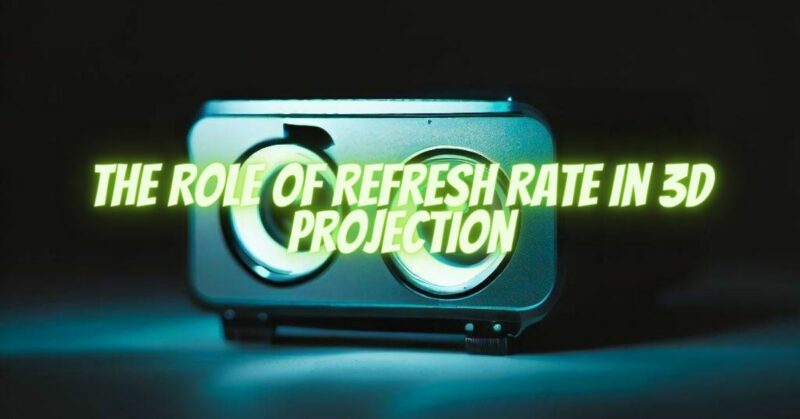In the realm of 3D projection, the refresh rate plays a significant role in delivering a captivating and immersive visual experience. The refresh rate directly influences the perceived depth, smoothness of motion, and overall visual quality in 3D content. In this article, we delve into the importance of refresh rate in 3D projection, exploring its impact on depth perception, reducing visual discomfort, and maximizing viewer engagement.
- Understanding Refresh Rate in 3D Projection: Refresh rate refers to the frequency at which images are refreshed on the screen. In the context of 3D projection, the refresh rate of the display device, such as a projector, determines how often the left and right eye images are updated. A higher refresh rate ensures smoother motion and reduces the potential for visual artifacts.
- Depth Perception and Immersion: The refresh rate significantly affects the perception of depth in 3D content. A higher refresh rate allows for more frequent updates of the left and right eye images, resulting in a smoother transition between frames. This smoothness enhances depth perception and contributes to a more immersive viewing experience, where objects and scenes appear more lifelike and three-dimensional.
- Motion Smoothness and Artifact Reduction: In 3D projection, fast-moving objects or camera panning can introduce motion blur or ghosting artifacts. A higher refresh rate minimizes these visual issues by providing more frequent updates, resulting in smoother motion reproduction. This smoothness reduces perceived blur and enhances the overall visual clarity and detail in dynamic 3D scenes.
- Reducing Visual Discomfort: Lower refresh rates in 3D projection can lead to visual discomfort, including eye strain, fatigue, and headaches. This discomfort may arise from the perception of flickering or judder, especially when viewing high-contrast or rapidly changing scenes. By increasing the refresh rate, the visual system perceives a more stable and continuous image, reducing the potential for discomfort and enhancing viewer comfort during prolonged 3D viewing sessions.
- Syncing with 3D Glasses and System Requirements: When using active shutter glasses or passive polarization systems for 3D projection, the refresh rate must be synchronized with the glasses or the polarization system. This synchronization ensures that each eye receives the appropriate image at the right time, maximizing the 3D effect. Consult the specifications of your 3D projection system to determine the recommended refresh rate for optimal compatibility and performance.
- Display Device Considerations: The capability of the display device, such as the projector or screen, influences the achievable refresh rate in 3D projection. Ensure that your chosen display device supports the desired refresh rate and can handle the demands of 3D content. Higher-end projectors or displays may offer higher refresh rates, providing a smoother and more immersive 3D experience.
- Balancing Refresh Rate and System Resources: Higher refresh rates require more processing power and system resources. Consider the capabilities of your 3D projection system, including the graphics processing unit (GPU), to ensure that it can handle the desired refresh rate without compromising overall performance or causing system overheating.
Conclusion:
In 3D projection, the refresh rate plays a vital role in enhancing depth perception, reducing visual discomfort, and maximizing viewer engagement. A higher refresh rate contributes to smoother motion, improved depth representation, and a more immersive visual experience. However, the achievable refresh rate depends on the capabilities of the display device and the synchronization requirements of the 3D projection system. By understanding the impact of refresh rate in 3D projection and considering the factors mentioned, you can optimize your setup to deliver captivating and realistic 3D visuals that truly mesmerize your audience.


